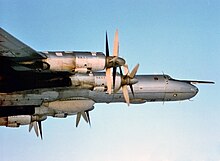Tupolev Tu-142
The Tupolev Tu-142 (Russian: Туполев Ту-142; NATO reporting name: Bear F/J) is a Soviet/Russian maritime reconnaissance and anti-submarine warfare (ASW) aircraft derived from the Tu-95 turboprop strategic bomber.The Tu-142 differed from the Tu-95 in having a stretched fuselage to accommodate specialised equipment for its ASW and surveillance roles, a reinforced undercarriage to support rough-field capability, improved avionics and weapons, and enhancements to general performance.[4] They had test-fired rocket boosters to perfect the design, culminating in the first underwater launch of a ballistic missile by USS George Washington on 20 July 1960.Tupolev initially designed the Tu-95PLO (protivolodochnaya oborona, or ASW), a development of the Tu-95 equipped with sonobuoys, anti-submarine mines and torpedoes.[6] The design was dropped, however, because it lacked a powerful radar, thermal imaging (infrared) system and magnetic anomaly detector (MAD).[6] On 28 February 1963, the Council of Ministers (the highest executive and administrative body of the Soviet Union) issued a directive to Tupolev requiring his bureau to develop a long-range ASW aircraft.[14] These changes, along with the deletion of the thermal imaging system and parts of the electronic countermeasure (ECM) equipment, reduced the empty weight by 4,000 kg (8,818 lb).[14] The modified aircraft also introduced a crew rest area for long-duration missions, and was assigned the codename ("Bear F" Mod 1); from 1968 to 1972 the Kuibyshev Plant produced a total of 18 Tu-142s.[15] The move required many improvements to the plant and the surrounding area, including the establishment of new assembly shops, the installation of new machinery and tooling, the re-training of the workforce, and the building of a new airfield.During 1961 and 1962, the Soviet Union conducted research and development into an explosive sound system (ESS) – used to locate deep-diving submarines – under the name Udar (Blow).This system was used for detecting surfaced and submerged submarines, communicating with other ASW aircraft and ground bases, and performing navigational and tactical tasks.[15] Meanwhile, the first Tu-142s were delivered to the Northern Fleet at Kipelovo AB, where they were initially tasked with tracking and monitoring nuclear-powered submarines as part of the type's operational trials.On 19–22 August 1974, four Tu-142s shadowed a foreign submarine in the Barents Sea; one of the aircraft was reported to have maintained continuous contact for 2 hours and 55 minutes.[29] Soviet Tu-142s, besides operating domestically, were sent to friendly overseas bases in Angola, Cuba, Ethiopia, Vietnam, and South Yemen.[33] In 1981 the Indian Navy began considering a long-range maritime reconnaissance and anti-submarine warfare aircraft for its Naval Air Arm.[40] On 7 November 2009, eleven crew were killed when their Tu-142 crashed on the Northwest Pacific coast of Russia over the Strait of Tartary between the island of Sakhalin and Khabarovsk region during a training flight.[55] There was no indication that the crew made use of emergency equipment, although a lifeboat on board the plane was fitted with a device that transmits a signal in the event of an accident.






Russian NavyMaritime patrolanti-submarine warfareTupolevKuibyshev Aviation PlantSoviet NavyIndian Naval Air ArmTupolev Tu-95RussianNATO reporting namemaritime reconnaissancestrategic bombercommunications dutiesballistic missile submarinesKuibyshev AviationUkrainian Air ForcePolaris programmeundercarriageavionicslong-rangepayloadKuznetsov NK-12MVturbopropscontra-rotatingUS NavyUGM-27 Polarissubmarine-launched ballistic missilerocket boostersballistic missileUSS George WashingtonCharlestonSouth CarolinaSoviet governmentdesign bureaussonobuoysanti-submarine minestorpedoesthermal imaging (infrared) systemmagnetic anomaly detectorCouncil of Ministersgun turretsdielectricradomeelectronic countermeasuresnavigation systemweapons targeting systemairfoilelevatorshydraulic actuatorsfuel tanksSamarafirst flighttest pilotZhukovsky AirfieldMoscowfuselageflight-test programmeSoviet Naval AviationTu-114airlinerengine nacelleelectronic countermeasureBlack SeacockpitLockheed P-3research and developmentIlyushin Il-38vertical stabiliserauxiliary power unitNorthernPacific FleetsRussian Naval AviationBoeing E-6 Mercuryradio aerialnuclear warsatellitescommand postsIlyushin Il-80command and controlKipelovomissileVladivostok International AirportNikolayevnuclear-powered submarinesinitial operational capabilityPacific FleetIlyushin Il-38 "May"INS HansaBarents SeaPhilippine SeaAngolaEthiopiaVietnamSouth Yemendissolution of the Soviet UnionSTART IturbojetenginesTu-22MZTu-144DTu-160Indian NavyNaval Air ArmIlyushin Il-38snaval air stationSimferopolCrimean peninsulaINAS 312INS RajaliBoeing P-8IsShetlandRussiaSVP-24Kamenny RucheyKhabarovsk KraiFedotovo (air base)Vologda OblastSoviet UnionSoviet Air ForcesRussian SFSRUkraineUkrainian SSRUkraine State Aviation MuseumAviation Technical Museum (Luhansk)Boeing P-8I PoseidonIlyushin Il-38SD Sea Dragon